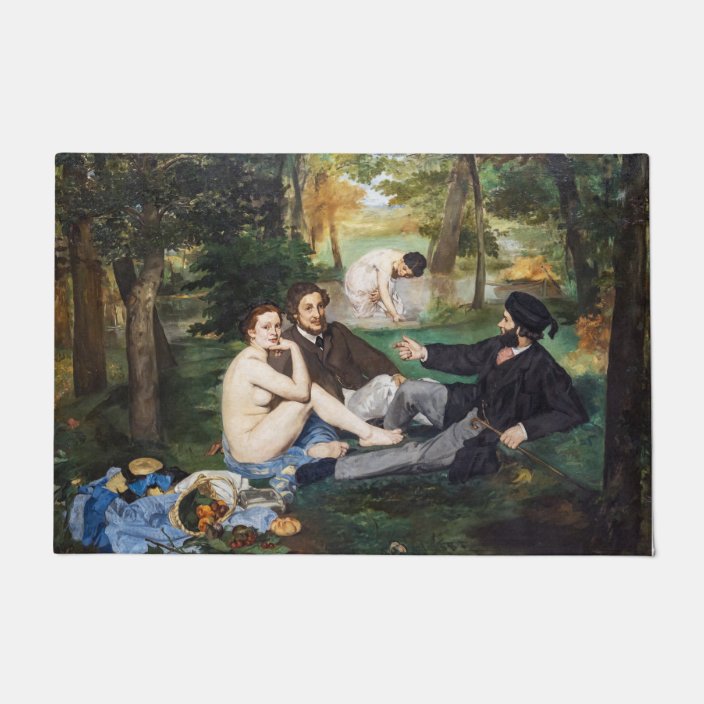


It was not Manet’s portrayal of a nude woman that shocked the viewers, but rather the lack of mythological or allegorical context as was the conventional justification for depicting a nude woman. The nude female is thought to be Victorine Meurent, who was also Manet’s model for Olympia. The male figures are thought to be based on one of Manet’s brothers, and the Dutch sculptor Ferdinand Leenhoff. Baudelaire named him ‘The Painter of Modern Life’ in his 1859 essay. Indeed both Zola and Baudelaire praised Manet for finally daring to depict modern life and to modernize classical painting. Similarly to the Impressionists, Manet took inspiration for his subject matter from real life, implying consequently that the figures in the painting were also taken from real life. Pastoral Concert, usually attributed to Titian, is a suggested inspiration for Manet’s The Luncheon on the Grass. However, these classical references are overshadowed by Manet’s clear refusal of other painterly conventions. The second is The Judgement of Paris, a scene from Greek mythology, from which Manet took inspiration for the figure’s reclining positions and gestures. The first is Titian’s Pastoral Concert, exhibited in the Louvre, from which Manet took the idea of contrasting clothed male figures with nude females, one of whom is also bathing.

Manet’s inspiration for the composition of The Luncheon on the Grass supposedly came from two sixteenth century Italian paintings. Manet’s inspiration for The Luncheon on the Grass The reason behind the painting’s scandal lies in its historical context and Manet’s treatment of the subject matter, scale and composition. This composition certainly remains puzzling even to twenty first century viewers, as one can’t help but wonder as to the reason behind her nudity, relaxed demeanor, and the two men’s seeming disinterest. Behind them, the second female bathes herself in a pool of water. The men appear to be in the midst of a discussion from which she is excluded, so she stares out to the viewer. A picnic basket is discarded in the foreground along with one of the female’s clothes, leaving her sitting naked between the two men. The Luncheon on the Grass depicts four figures, two male and two female, lounging in a landscape setting. However, to contemporary eyes it may not be immediately evident what about this painting was so shocking to the audience of 1863. The Luncheon on the Grass was rejected from the 1863 Salon and exhibited instead at the Salon des Refusés where it caused great scandal. The Scandal behind The Luncheon on the Grass Édouard Manet, photographed by Nadar in 1874. Today his work holds an essential place in the history of art as the starting point of Modernism. He was close friends with many of the impressionist painters during his lifetime and although his work was often ridiculed and widely mocked by contemporary critics, he was also supported by other creative minds of his time such as Emile Zola and Charles Baudelaire. Indeed, although Manet considered himself a realist, his radical style and subject matter has seen him classed as both the father of Impressionism and a pioneer of modernism. He was inspired by the works of the realist painter Gustave Courbet in his early works but soon came to reject the conventions of painting leading to masterpieces such as Olympia and The Luncheon on the Grass (both painted in 1863). Manet’s work bridged the gap between Realism and Modernism. During this time he also traveled extensively around Germany, Italy and the Netherlands and was influenced by the work of artists like Frans Hals, Diego Velazquez and Francisco Jose de Goya. From 1850 to 1856 he trained under the academic painter Thomas Couture and complemented his education by copying the Old Masters exhibited at the Louvre. He was expected to pursue a respectable career in law but instead followed the encouragement of his uncle and became a painter. Édouard Manet (1832-1883) was a French modernist painter born in Paris to a wealthy family. In this article, Singulart dissects the scandal behind Manet’s masterpiece and its influence on the history of art. Portraying an ordinary scene of everyday life on a scale previously reserved for great historical or mythological compositions, Manet rejected the conventions of classical painting to forge a path toward Modernism. Hailed as the first modern painting, Manet’s The Luncheon on the Grass was as scandalous as it was revolutionary.


 0 kommentar(er)
0 kommentar(er)
